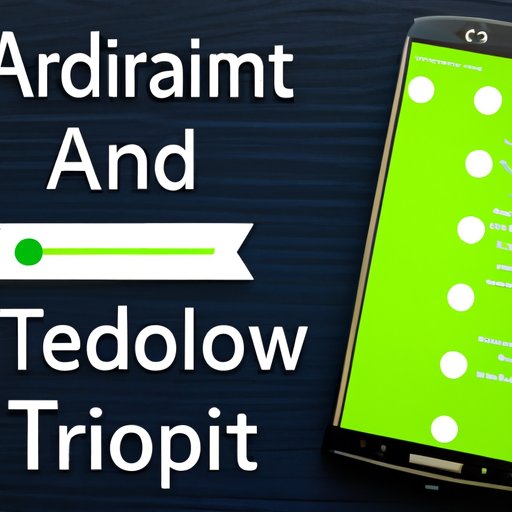
I. Introduction
Have you ever come across something on your Android device that you want to save or share with others? Maybe it’s a funny meme, an important email, or a piece of information that you don’t want to forget. Whatever it is, taking a screenshot of your Android device is a simple and effective way to capture that content.
In this article, we’ll explore how to take a screenshot on your Android device. We’ll go over everything from step-by-step instructions to troubleshooting tips to app recommendations. By the end of this article, you’ll have all the knowledge you need to take screenshots on your Android device like a pro.
II. Step-by-step guide
The process of taking a screenshot on an Android device is relatively straightforward, but it’s important to follow each step carefully to ensure that you capture the content you want. Here’s a step-by-step guide:
- Open the screen or app that you want to capture.
- Press and hold the power button and the volume down button at the same time. (Note: The exact buttons to press may vary depending on the make and model of your Android device. Some devices may use the power button and home button, for example.)
- You may hear a clicking sound or see a visual indication that the screenshot was taken.
- Find the screenshot in your Gallery app or in the Notifications panel. It will be saved as an image file.
- From here, you can edit the screenshot, share it via text or email, or save it to your device or cloud storage.
It’s important to note that some Android devices may have slightly different instructions for taking a screenshot. If you encounter any issues, try a quick Google search using your device’s make and model to find specific instructions.
III. Video tutorial
If you prefer a visual demonstration on how to take a screenshot on your Android device, a video tutorial can be a helpful tool. Check out this step-by-step video tutorial:
IV. List of keyboard shortcuts
If you take a lot of screenshots on your Android device, using keyboard shortcuts can make the process even easier. Here are some common keyboard shortcuts for taking screenshots:
- Power button + volume down button
- Power button + home button (for devices with a physical home button)
- Three-finger swipe down (for devices with this feature enabled)
To use these shortcuts, simply press the buttons or swipe down with three fingers at the same time. You’ll hear or see a visual indication that the screenshot was taken, and you can then find it in your Gallery app or Notifications panel.
V. Comparison of different Android versions
The process of taking a screenshot can vary depending on the version of Android that your device is running. Here’s a quick comparison of the different ways to take a screenshot on different versions of Android:
- Android 4.0 or later: Press and hold the power button and volume down button at the same time.
- Android 2.3 to 3.0: Press and hold the power button and home button at the same time.
- Android 1.6 to 2.2: There is no built-in screenshot feature, but you can use third-party apps to take screenshots.
It’s important to note that these are general guidelines, and your device may have slightly different instructions. Always refer to your device’s user manual or do a quick Google search for specific instructions.
VI. Troubleshooting tips
Even if you follow all the steps carefully, you may still encounter issues when taking a screenshot on your Android device. Here are some common problems and how to troubleshoot them:
- The screenshot is blurry or incomplete: This may be due to pressing the buttons too quickly or not holding them down for long enough. Try holding the buttons for a few extra seconds to ensure a clear and complete screenshot.
- The screenshot doesn’t save: This can sometimes happen if your device is low on storage. Try deleting some old files or moving files to a different storage location.
- You can’t find the screenshot: The screenshot may be saved in a different folder than you expect. Check your Gallery app or Notifications panel to see if it’s there, and consider using a file manager app to search for it.
VII. Third-party app recommendations
While the built-in screenshot feature on Android devices is usually easy to use, there may be situations where you want more control or advanced features. That’s where third-party screenshot apps come in. Here are some of the best apps available:
- Screenshot Easy: This app allows you to take screenshots with one hand and includes a variety of editing tools.
- Screenshot Snap: With this app, you can take a screenshot by shaking your device or using the notification bar, and there are options for editing and sharing your screenshots.
- Super Screenshot: This app includes advanced features like scrolling screens, capturing videos, and annotating screenshots.
When using third-party apps, be sure to carefully read the permissions and reviews before downloading to ensure that the app is safe and effective.
VIII. Conclusion
Taking a screenshot on your Android device is a simple and effective way to capture content like images, emails, and information. By following the steps in this article, you’ll be able to take screenshots like a pro. Don’t be afraid to experiment with different methods and apps to find the one that works best for you.





